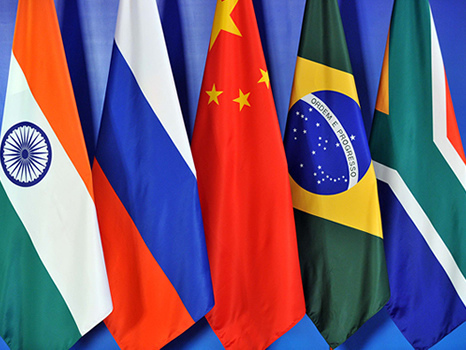
They represent 25.9 percent of the world’s land mass, 43 percent of the population and 17 percent of global trade. The UN Development Program states that by “2020, the combined economic output of three leading developing countries alone Brazil, China, and India–will surpass the aggregate production of Canada, France, Germany, Italy, and the United States.”
Wednesday the five BRICS countries (Brazil, Russia, India, China, and South Africa) at their fifth annual summit in Durban announced a new BRICS Bank, under the catchy 1960s throwback title of “Partnership for Development, Integration, and Industrialization.” The aim of the Fabulous Five is clear; to counterbalance what they see as a) the western-dominated International Monetary Fund and World Bank; and b) plug a gap in development financing caused by the West’s financial and economic woes. Are the BRICS laying the foundation of a new world order?
On the strategic face of it the Durban summit would seem a natural extension of Chinese President Xi Jingping’s Kissingeresque Moscow démarche of last week. Clearly, the vacuum created in strategic leadership by the West’s rapid decline, accentuated and accelerated by the EU/Germany’s incompetent handling of the Cyprus default, will see new actors emerge. However, for all the clear ambitions of China (and to a markedly lesser extent Russia) the five countries are still divided on many issues.
The most obvious is the strategic provenance of the BRICS. While China and Russia clearly think in terms of classical Kennanesque Cold War Realism, and thus see the strategic game with the West as ultimately zero sum, Brazil and India come from that rather woolly tradition of non-alignment. The Non-Aligned Movement emerged in the 1960s as an attempt by India in particular not to be dragged into somebody else’s potentially destructive grand strategy. For a country that had lost well over a million people fighting Britain’s grand and not-so-grand wars, this made sense.
Today, India is emerging in its own right and is as a much regional-strategic competitor of China as partner, particularly given China’s role in nuclearizing New Delhi’s arch-adversary, Islamabad. To that end, as an example of constructive multilateralism, a BRICS that promotes stability and co-operation rather than competition is a good thing.
Brazil fits into pretty much the same category as India. At several conferences of late I have attended the Brazilians present clearly identified their strategic interests with those of the West. Moreover, in my Oxford Handbook of War a leading Franco-Brazilian academic summed up Brazil’s foreign policy as essentially Latin American in focus and by and large aligned with that of the US, so long as Washington worked with Brazil. The BRICS can thus be seen very much in the light of a Brazil keen to remind America of its burgeoning regional-strategic influence.
As for South Africa, the ANC-led government still sees its roots as having been established in a form of colonial war and as such is instinctively drawn to any form of non-alignment with a vague anti-Western tinge. And, of course, Pretoria is desperately in need of Chinese capital.
Furthermore, for all the grandiose talk last week of a new strategic partnership between Russia and China, Moscow has no desire to be Athens to China’s Rome, particularly if tensions between the United States and China reach a point where Moscow’s commercial and energy relationship with Europe is affected. That may change over time but Moscow will continue to hedge its strategic bets.
However, if there are divisions between the BRICS based on geography, alignment, and allegiance there are also huge gaps. Indeed, it is the issue of capital that will most probably highlight such gaps. The choice of “partnership” as the key word for the summit is critical. If the BRICS become seen too overtly as part of a new Chinasphere it will rapidly fall apart. However, partnership means equality and the word at the summit is that each member will put some $10bn (€7.8bn) into the BRICS Bank. This figure represents only 0.1 percent of Chinese GDP and yet some 2 percent of South African.
Therefore, for the moment the BRICS will remain far more a non-aligned movement than a counter-balancing mechanism. However, it is the long-term context that makes the BRICS interesting. One report suggests that while Asia alone accounts today for some 24 percent of world trade, it will be 42 percent by 2030 and 48 percent by 2050. Whereas thanks to the EU, Europe’s mutual impoverishment pact, whilst Western Europe represented 48 percent of world trade in 1990, it is 34 percent today and likely to fall to 19 percent in 2030 and 15 percent by 2050.
If the report is right the BRICS could one day find itself at the very core of a new world order. This summit is clearly building BRICS for the future.
Julian Lindley-French is a member of the Atlantic Council’s Strategic Advisory Group. This essay first appeared on his personal blog, Lindley-French’s Blog Blast.
Photo credit: Flickr user GovernmentZA
Image: 8286393751_f615346299.jpg
